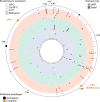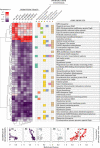The effect of a temperature-sensitive prophage on the evolution of virulence in an opportunistic bacterial pathogen
- PMID: 35917247
- PMCID: PMC9826266
- DOI: 10.1111/mec.16638
The effect of a temperature-sensitive prophage on the evolution of virulence in an opportunistic bacterial pathogen
Abstract
Viruses are key actors of ecosystems and have major impacts on global biogeochemical cycles. Prophages deserve particular attention as they are ubiquitous in bacterial genomes and can enter a lytic cycle when triggered by environmental conditions. We explored how temperature affects the interactions between prophages and other biological levels using an opportunistic pathogen, the bacterium Serratia marcescens, which harbours several prophages and that had undergone an evolution experiment under several temperature regimes. We found that the release of one of the prophages was temperature-sensitive and malleable to evolutionary changes. We further discovered that the virulence of the bacterium in an insect model also evolved and was positively correlated with phage release rates. We determined through analysis of genetic and epigenetic data that changes in the bacterial outer cell wall structure possibly explain this phenomenon. We hypothezise that the temperature-dependent phage release rate acted as a selection pressure on S. marcescens and that it resulted in modified bacterial virulence in the insect host. Our study system illustrates how viruses can mediate the influence of abiotic environmental changes to other biological levels and thus be involved in ecosystem feedback loops.
Keywords: epigenetics; experimental evolution; opportunistic pathogen; prophage induction.
© 2022 The Authors. Molecular Ecology published by John Wiley & Sons Ltd.
Conflict of interest statement
The authors declare no competing financial interests.
Figures








Similar articles
-
Plasmid-Mediated Stabilization of Prophages.mSphere. 2022 Apr 27;7(2):e0093021. doi: 10.1128/msphere.00930-21. Epub 2022 Mar 21. mSphere. 2022. PMID: 35311569 Free PMC article.
-
The defective prophage pool of Escherichia coli O157: prophage-prophage interactions potentiate horizontal transfer of virulence determinants.PLoS Pathog. 2009 May;5(5):e1000408. doi: 10.1371/journal.ppat.1000408. Epub 2009 May 1. PLoS Pathog. 2009. PMID: 19412337 Free PMC article.
-
Deciphering Active Prophages from Metagenomes.mSystems. 2022 Apr 26;7(2):e0008422. doi: 10.1128/msystems.00084-22. Epub 2022 Mar 24. mSystems. 2022. PMID: 35323045 Free PMC article.
-
The Bacteriophages of Streptococcus pyogenes.Microbiol Spectr. 2019 May;7(3):10.1128/microbiolspec.gpp3-0059-2018. doi: 10.1128/microbiolspec.GPP3-0059-2018. Microbiol Spectr. 2019. PMID: 31111820 Free PMC article. Review.
-
Lysogeny in the oceans: Lessons from cultivated model systems and a reanalysis of its prevalence.Environ Microbiol. 2020 Dec;22(12):4919-4933. doi: 10.1111/1462-2920.15233. Epub 2020 Sep 29. Environ Microbiol. 2020. PMID: 32935433 Review.
Cited by
-
The spontaneously produced lysogenic prophage phi456 promotes bacterial resistance to adverse environments and enhances the colonization ability of avian pathogenic Escherichia coli strain DE456.Vet Res. 2024 Mar 26;55(1):37. doi: 10.1186/s13567-024-01292-z. Vet Res. 2024. PMID: 38532498 Free PMC article.
-
Prophage-DB: A comprehensive database to explore diversity, distribution, and ecology of prophages.bioRxiv [Preprint]. 2024 Jul 16:2024.07.11.603044. doi: 10.1101/2024.07.11.603044. bioRxiv. 2024. Update in: Environ Microbiome. 2025 Jan 13;20(1):5. doi: 10.1186/s40793-024-00659-1. PMID: 39071402 Free PMC article. Updated. Preprint.
-
Insect immunity in the Anthropocene.Biol Rev Camb Philos Soc. 2025 Apr;100(2):698-723. doi: 10.1111/brv.13158. Epub 2024 Nov 5. Biol Rev Camb Philos Soc. 2025. PMID: 39500735 Free PMC article. Review.
-
Induced Burkholderia prophages detected from the hemoculture: a biomarker for Burkholderia pseudomallei infection.Front Microbiol. 2024 Apr 2;15:1361121. doi: 10.3389/fmicb.2024.1361121. eCollection 2024. Front Microbiol. 2024. PMID: 38633694 Free PMC article.
-
Exploring Viral Interactions in Clavibacter Species: In Silico Analysis of Prophage Prevalence and Antiviral Defenses.Life (Basel). 2025 Jan 27;15(2):187. doi: 10.3390/life15020187. Life (Basel). 2025. PMID: 40003596 Free PMC article.
References
-
- Argov, T. , Azulay, G. , Pasechnek, A. , Stadnyuk, O. , Ran‐Sapir, S. , Borovok, I. , Sigal, N. , & Herskovits, A. A. (2017). Temperate bacteriophages as regulators of host behavior. Current Opinion in Microbiology, 38, 81–87. - PubMed
-
- Benjamini, Y. , & Hochberg, Y. (1995). Controlling the false discovery rate: A practical and powerful approach to multiple testing. Journal of the Royal Statistical Society: Series B: Methodological, 57(1), 289–300.
Publication types
MeSH terms
LinkOut - more resources
Full Text Sources
Other Literature Sources
Molecular Biology Databases

